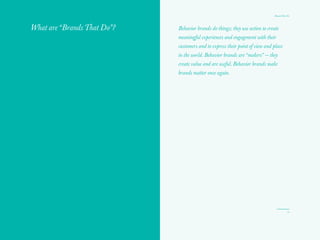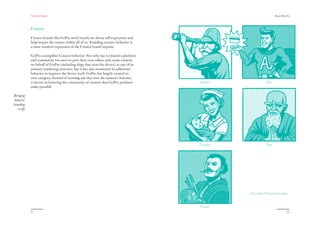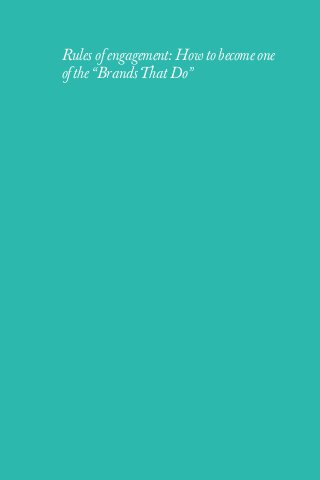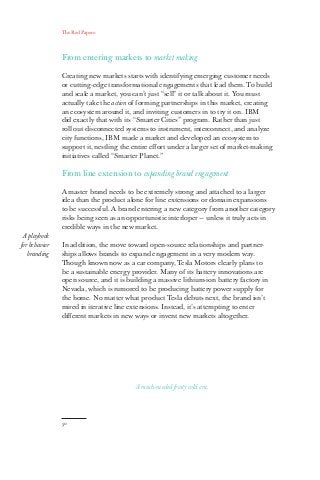Brands That Do: Building Behavior Brands
- 1. The Red Papers: TM Ogilvy & Mather Brands That Do: Building Behavior Brands Susan Machtiger & Jaime Prieto
- 3. The Red Papers: TM Ogilvy & Mather Brands That Do: Building Behavior Brands Susan Machtiger & Jaime Prieto
- 4. Time to be on your best behavior Why now? What are “Brands That Do”? How behavior brands behave Beyond purpose A new generation of action: Gen B, the behavior generation Bringing behavior branding to life Behavior branding through archetypes Behavior branding as competitive insulation Behavior branding in real time Content in response to the great fragmentation Behavior branding in B2C The Red Papers: 6 12 14 18 23 24 28 30 34 35 36 39 Contents
- 5. Rules of engagement: How to become one of the “Brands That Do” A playbook for behavior branding How should a CMO behave? Conclusion Key takeaways References About the authors 40 44 52 56 60 64 66 October 2015, No. 8
- 7. 5 Brands That Do Is your brand a hero in the eyes of consumers? Well, that depends on what it does.
- 8. Time to be on your best behavior
- 9. 7 Is it the “Great Age of the Brand,” as business guru Tom Peters has declared, or is it the “Twilight of the Brands,” as James Surowiecki heralded this past year in The New Yorker? These divergent views reflect the paradox of brand building today. What a brand is and what it means in a world of fragmentation, consumer control, and content overload is in a state of challenge, questioning, and turbulence. Brands That Do
- 10. The Red Papers:
- 11. Brands That Do 9 Ogilvy & Mather’s Make Brands Matter research recently reported that most people — 79 percent in the United States and 77 percent in the United Kingdom — didn’t think brands mattered that much at all to them. That should terrify all of us as marketers and as businesspeople. However, consider this more deeply: Over 75 percent of brands are so meaningless to consumers that they may as well not be there. They are brands that are of no consequence — just names on products or services. There is hope. Our research found that brands around the world matter in different ways than they did before. People want brands that act, that help, that do. Consumers are sending a very clear message that challenges every part of a business — from finances to operations to marketing. Consumers are telling us to stop making empty promises and start acting in new and different ways. In other words, we should be building brands that do things that matter to their customers. There is an important lesson companies and brands can learn here. In order to succeed in today’s environment, most companies need to rethink how they build and care for their brands. Some, however, are on the frontier of not just a new way of branding but a new way of behaving as well. Historically, brands have relied on disseminating their own messaging and communications in the hope that audiences would listen and act on what they heard. But our guides have figured out a new way, and in the pages that follow, we’ll learn from them. Before we begin, let’s assess where your brand sits in its evolution when it comes to its own behavior and actions. The following questions may appear glib, but their answers accurately reflect the tensions of the shifting states at a large number of our clients today. A moment of silence, please, for all the brands that don’t matter.
- 12. 10 Yes No The Red Papers: Time to be on your best behavior Our behavior brand diagnostic 1. Does the marketing planning cycle dominate activity, or at least mental activity, to the detriment of doing things in market? Do you spend more time planning than executing? 2. Do you spend more time tracking traditional research metrics, revenue, and share than listening to your consumers and immersing yourself in your markets and the world at large to understand the context of where your brand lives? 3. Do you spend more time developing messaging architectures than designing customer and brand experiences? 4. Do you have only secondhand knowledge of the touch points for, instead of firsthand understanding of, your customers’ experience? Especially the segregated, “behind the walls” customer service call center? 5. Does your brand live on paper instead of delivering genuine service, utility, and value to your customers’ lives? 6. Is your brand a business label rather than a genuinely likeable relationship partner with whom you could spend an exciting and interesting day? 7. Do you only track your traditional competitors or are you following the actions of disruptors outside your category? 8. Do your customers experience a predictable loop of customer service instead of feeling they are in a genuine, human relationship?
- 13. Brands That Do 11 Yes No 9. When you create marketing and communications, do you consider just a call to action instead of opening up pathways for continued engagement? 10. Does your brand just claim a higher purpose in place of continuous conduct to advance that agenda and engender loyalty through action? 11. Are you presenting something highly scripted to your consumers instead of inviting them in transparently? 12. Is marketing a continuous monotone instead of a program of signature moves — singular, bold actions that bring to life what you stand for? 13. Do you continue to measure brand awareness vs. embracing measures such as impact and talkability? 14. Are your employees brand ambassadors of a message or are they living and acting on the brand’s values in every customer encounter? 15. Do you spend significant time crafting what your brand will say instead of what (actions) your brand can do? If you have checked “Yes” more often than “No,” it may be time to take a fresh look and rethink how you are building your brand. Brand building for the future means devising new strategies to meet the expectations of multichannel customers, capitalizing on the possibilities that new technologies enable (geo-targeting, personalization, and automation, to mention just a few), and even changing the makeup of the marketing team to ensure the right skill set is in place.
- 14. The Red Papers: 12 Why now? The rhetoric of brands acting, not talking, is not new: Jeremy Bullmore talked about brand behavior in the 1980s. Nor is the tech that enables this behavior new. It’s been around from the beginning of the digital transformation. While neither the technology nor the rhetoric is new, the maturation of both — plus a heavy dose of marketing ennui — has brought us to a tipping point. We are definitely in the Age of the Customer, a time when brands have fully embraced the fact that they don’t create themselves. Customers have significant impact on how brands are built, and brands cannot abstain from ongoing interaction. Realizing this is one thing. Adapting to it requires a shift in thinking and, ultimately, behavior that hasn’t happened yet. We call that shift Behavior Branding. Behavior branding asks brands to do, not just say. It demands that brands stop asserting beliefs and start demonstrating value. Time to be on your best behavior
- 15. 13 Brands That Do Behavior branding asks brands to do, not just say. It demands that brands stop asserting beliefs and start demonstrating value.
- 16. About the authorsWhat are “Brands That Do”?
- 17. Behavior brands do things; they use action to create meaningful experiences and engagement with their customers and to express their point of view and place in the world. Behavior brands are “makers” — they create value and are useful. Behavior brands make brands matter once again. 15 Brands That Do
- 18. The Red Papers: 16 In Faris Yakob’s book Paid Attention: Innovative Advertising for a Digital World, he calls for brands to “Do Things, Tell People,” with action as the foundation of content creation and sharing. If brands do things that matter to people and then tell the story of that action, they will ignite compelling content and sharing of that content. In a world of infinite content, this makes behavior branding an engine of relevant content creation and organic sharing. By making your brand behave in more deliberate and authentic ways, you prove your worth, invite participation, and create a distinctive point of view and track record that is less vulnerable to copying by competitors. What are “Brands That Do”? How to build meaningful engagement in two easy steps.
- 19. Brands That Do 17 I LOHAS, a late-entrant bottled water from Coca-Cola, went from last place to the top water brand in Japan in all channels in six months. I LOHAS made a behavior — crushing the bottle to signify your commitment to the environment — the center of its marketing with astonishing results. New packaging that significantly reduced environmental impact; street art projects constructed from recycled, crushed bottles; and a documentary film that evangelized the idea of light packaging as beautiful object inspired a transformative content/social strategy that toppled the Japanese water market. Behavior brands shift emphasis In Thailand, having talked with mothers for years, Nestlé understood that, more than anything, mothers were becoming overwhelmed by juggling a multitude of responsibilities. So becoming a mother’s extra pair of hands to help her along the way became Nestlé’s key goal. The brand launched the Good Food, Good Life Community — a network of mothers and experts providing access to knowledge, solutions, and advice through communities based on women’s immediate and evolving needs. Mothers use it to find help and advice, whether they’re concerned about nutrition or health or wellness advice or simply focused on finding a great meal to cook for the family. They’re rewarded for sharing, discussing, and collaborating. From the brand’s perspective, Nestlé has created a new level of engagement by listening to their concerns and then behaving in a way that helps, connects, and rewards. From What they say What you read about them Stating beliefs and values To What they do What you experience Living them consistently through actions
- 20. About the authorsHow behavior brands behave
- 21. 19 Brands That Do We’ve learned through research and practice that the way a company or brand behaves and acts — as well as what they do and what they make — has far greater influence on someone’s interest and involvement than any individual product or service they sell. It makes sense. Products and services proliferate and are often interchangeable. They mostly all meet consumers’ needs, yet marketers still seek that elusive “differentiation” that will distinguish their brand from others. Particularly in technology, these differences disappear almost as soon as they are identified. Today, a brand is useful, meaningful, and engaging — or it is moving toward irrelevance.
- 22. The Red Papers: 20 Implications for a new approach to branding How behavior brands behave From Fixed brand strategy statements Owned/earned activated by paid media Offering messages or declarations Position like a marketer Philosophy around innovation Stunts and media attention After-the-fact learning To Dynamic brand behavior blueprints Deep content, seamless experiences, activated by action Being useful Acts like a person Innovation in all you do Authentic actions Experimentation A blueprint for brand behavior.
- 23. Brands That Do 21 From fixed brand strategy statements to dynamic brand behavior blueprints In today’s dynamic communications world, many of us are still using static, longstanding tools such as traditional positioning statements, with reasons to believe, rational differentiators, and personality words grafted onto a brand. While there has been a move to more customer- centric, integrated communications planning, it rarely includes actions or behaviors at its heart. While brands will continue to need their North Star — their unique DNA expressed in brand ideas and platforms — we are calling for a shift in emphasis from strategy words on a page to translation and activation of brand ideas into actions and behaviors, both internally and externally. Developing a brand behavior blueprint with the customer at the center, instead of simply an integrated communications plan, would ensure that brands do things that mattered to their customers and the world. From owned/earned activated by paid media to deep content, seamless experiences, activated by action The Paid, Owned, Earned model is accepted practice today, along with the assumption that paid media can amplify and activate owned and earned. To deliver the shift to “Do Things, Tell People,” we see brand behaviors and actions as the engines of amplification for deep, relevant content of all kinds. From offering messages or declarations to being useful This shift from traditional communications messaging to content that has utility means that every time we engage with a person, we should create some kind of value for them, in order to make our brand matter in their lives. From position like a marketer to acts like a person The language of “marketer” and “consumer” does little to inspire authentic behavior from a brand or a company. Brands often search for new “positionings” to “target audiences” that will transform their brand malaise. It is easy to make these shifts on paper, but when was the last
- 24. The Red Papers: 22 time any of us experienced a shift to a new real, authentic relationship with a product or company? People want human relationships, not corporate ones. From philosophy around innovation to innovation in all you do Many companies claim to be innovative, but Uniqlo is an example of a brand built on innovative behavior. From product innovation (Heattech, AIRism, Light Down) to innovative consumer engagement (lifestyle enhancement apps) to the CEO’s obsession with finding new ways to deliver value, the actions have built a brand that matters. From stunts and media attention to authentic actions Red Bull’s stunts have indeed resulted in significant attention, but we believe authentic actions that connect with your customers have more real, longlasting impact. Citi Bike, Citi Pond, and Citi Field have daily impact on the fabric and life of New York City. From after-the-fact learning to experimentation The majority of brand health studies are annual or biannual. By the time the report is provided, the ability to act or impact has passed. Real-time market tracking and continuous learning across a range of activities generate greater insight and inspire more accurate brand action. How behavior brands behave
- 25. Brands That Do 23 Beyond purpose The rise in importance of concepts like corporate purpose, shared value, and collective value has inspired company after company to seek higher- order meaning. Discovering what they stand for and why their employees should come to work every day, particularly for millennials who value life over work, is an urgent quest. This is now a strategic business driver that informs decisions and actions. It’s not window dressing like CSR programs of the past. Purpose and values are more credibly brought to life through behavior, action, and creation than they are through generic internal statements of values or gratuitous nonprofit activity. In fact, tangible action can be a vivid, credible demonstration of a company’s purpose or product’s value proposition to its customers. If most people don’t care if 70 percent of brands disappeared, brands need to create real value in order to matter. These days, articulating purpose alone is not enough — at the heart of brand behavior lie human truths. We need to articulate a new social contract between customers, communities, and companies. Brands, through their actions and values, can become guardians of audience sensibility and values. In short, we need to think about how brands can be useful and contribute to our world.
- 26. About the authorsA new generation of action: Gen B, the behavior generation
- 27. There is evidence of a new type of consumer whose behavior forms a common cultural mindset. We’ve elected to call them Gen B, the behavior generation, even though they span different ages and classes. It’s enormously important to understand not just what they do, but why they behave as they do. 25 Brands That Do
- 28. The Red Papers: 26 We see behavioral change sweeping across culture and category. Consumers are becoming more self-directed about health and exercise by wearing fitness trackers. They’re traveling to volunteer for nonprofits, creating a whole new category of “eco-tourism.” They’re funding good ideas through Kickstarter. Materialism has given way to experience as a form of social currency, and doing/engaging/acting is the new badge. What you have, who you are, and how you express your values is defined through action and impact — whether through your social footprint, sharing, or networking. While baby boomers have been deemed change-makers at every turn, millennials have also emerged as engines of action. They have taken personal responsibility to tackle issues they care about and let their lives be guided by their values rather than external measures. Teach For America has exploded in popularity. Working for an NGO is a sign of success and values, not an inability to get a real job. Business-school graduates now predominantly choose startups over traditional investment banking and consulting firms. Startups have values and purpose and allow for personal action and impact. Gen B respects doers, not talkers. They want to see values connected to actual behaviors. And they engage with brands they see as acting according to their values. Realizing the need to interact with Gen B in ways that leave them rewarded, behavior brands have provided superior value in creative ways that go beyond the product experience. Coke’s call to “Open Happiness” inspired a social and digital movement of actions that create happiness, such as planting trees, paying a stranger’s toll, and hanging swings anywhere. A new generation of action: Gen B, the behavior generation Gen B takes action, funding good ideas and tracking life in real time.
- 29. Brands That Do
- 30. About the authorsBringing behavior branding to life
- 31. Knowing that brands today need to act, not just speak, how do you define or inspire your brand behaviors? What is your behavior persona? Are you an uncle, a best friend, an enabler, or a protector? 29 Brands That Do
- 32. The Red Papers: 30 Behavior branding through archetypes One way to be inspired is through the lens of archetypal thinking, as laid out in Margaret Mark and Carol S. Pearson’s book, The Hero and the Outlaw. While there are 12 canonical archetypes, we have focused on five as exam- ples to get you started. Explorer Explorer brands like Patagonia, Starbucks, and Amazon enable exploration of the world and, in the process, help people find themselves. The Explorer’s brand behavior would mean serving as a catalyst for adventure or becoming the friend that supports the quest for individuality. Rapha is a global cycling gear brand that has done phenomenal brand building over the past six to eight years through taking Explorer-inspired actions. The brand has opened Rapha cafes cum cycling clubs, set up local rides, created top-notch riding trips, and partnered with Strava GPS run and ride trackers, all of which created relevant and useful content that inspired a growing community around cycling. Hero Hero brands are vehicles to prove one’s worth through courageous and difficult action, exerting mastery in a way that improves the world. Consumers interested in Hero brands like Nike are hungry for powerful convictions and attracted to people, companies, and brands that possess them and, more importantly, take on the action themselves. If you are a Hero brand, act like one. American Express’s Small Business Saturday continues to represent the kind of action that a Hero brand would take to help small U.S. businesses. Small Business Saturday emerged during the worst of the financial meltdown — when consumers and businesses alike were battered by economic contraction. Rather than cost cutting and letting smaller businesses weather the storm as best they could, American Express decided to lend its coordinated, national, large-scale marketing prowess to these critical businesses. It focused national attention on small businesses and their role in our communities while also shoring up the brand’s penetration Bringing behavior branding to life
- 33. Brands That Do 31 into a historically underperforming segment. Instead of just creating content focused on small business issues, its actions were the content. An old example, but visionary. Caregiver Caregiver brands like Johnson Johnson and Aetna protect people from harm and help others with compassion and generosity. One of the original brand behaviors that positively impacted the JJ brand for decades to come was immediately removing every bottle of Tylenol from store shelves after the threat of tampering emerged in 1982. TOMS Shoes is a Caregiver brand, caring for people across the globe. Behind the well-known “One for One” model is a range of authentic behaviors, including “Start Something That Matters” challenges that fund social entrepreneurship. They have inspired 1,000+ supporter-led events annually, creating a ripple of action. Sage Sage brands like IBM, DuPont, and Oprah enable the discovery of truth and use intelligence to understand the world. They demonstrate behaviors and actions that make a brand an enabler of expertise or a guide to knowledge. One of IBM’s research labs developed the ability to move individual atoms. That’s an intriguing idea, but it’s inherently remote. Rather than leave the discovery in the lab until such time as molecular memory — the eventual commercialization — matured, IBM dedicated a whole lab to the production of the smallest movie ever: A Boy and His Atom. While only a simple story, the film was made by moving individual atoms to create charming animation. Shown in classrooms and at film festivals, the film enabled everyone to learn and share in the wonder of discovery.
- 34. The Red Papers: 32 Creator Creator brands like GoPro and Crayola are about self-expression and help inspire the creator within all of us. Enabling creative behavior is a more modern expression of the Creator brand impulse. GoPro exemplifies Creator behavior. Not only has it created a platform and community for users to post their own videos and create content on behalf of GoPro (including dogs that wear the device) as one of its primary marketing activities, but it has also monitored its adherents’ behavior to improve the device itself. GoPro has largely created its own category. Instead of running ads that tout the camera’s features, it invests in fostering the community of creators that GoPro products make possible. Bringing behavior branding to life
- 35. Brands That Do 33 Five of the 12 brand archetypes. Hero Sage Explorer Caregiver Creator
- 36. The Red Papers: 34 Behavior branding as competitive insulation Behavior branding provides greater competitive insulation in a marketing- and product-saturated world. Which is more credible, the brand and company that lives and acts its point of view every day or the one that merely claims to do so? Once these actions and beliefs are associated with a brand, it is very difficult for competitors to shake them loose. No cosmetic brand today could truly imitate Dove’s Campaign for Real Beauty when, for over 10 years, the brand has disrupted the global conversation about real beauty and women’s self-esteem. Amazon has a long-held belief that investing its dollars to help improve the shopping experience for their customers is the best way of creating loyalty in an exploding e-commerce world rather than creating messaging. 1-Click, peer reviews, Prime, and recommendations are all examples of investments that improve the site’s utility for its customers. These have all built strong customer loyalty. Everlane, an online fashion brand, champions “Radical Transparency.” Its website content features its manufacturing processes and locations, including interviews with Everlane’s garment workers. Zady, another online fashion retailer, is calling for a “Sourced In” movement in which businesses are expected to be accountable for every step of production, from farm to finished product. This kind of active transparency of behavior has already been fertile territory in driving competitive differentiation for brands like Chipotle and Patagonia. Bringing behavior branding to life
- 37. Brands That Do 35 Behavior branding in real time An annual plan that lays out marketing activities a year in advance is quickly becoming a relic. The real-time nature of branding today reframes the idea of such a planning cycle. CMOs who spend months crystallizing plans rather than taking relevant action in response to customers are quickly falling behind. Marketing and branding today live in a cultural context more vivid than ever before, now that the walls of the traditional-media ivory tower have collapsed. These days, the always-on news cycle exemplified by instant, 360-degree Twitter coverage of every world event is the media norm. In this environment, outbound planned marketing activities can be disrupted overnight. Consistent, authentic behaviors that maintain a true- north orientation are much more effective than contrived marketing stunts. In fact, iterative marketing that tries and fails sometimes, but at least is contextually relevant, often is more engaging than a perfectly executed marketing program. Google, now Alphabet, is a company that lives in real time, continuously responding and adapting to opportunities in the world. Born as a search engine, it has been acquiring more than one company per week since 2010 and creating new visionary businesses from energy to transportation to robotics.
- 38. The Red Papers: 36 Content in response to the great fragmentation While nearly all marketers are shifting to viewing themselves as content managers and publishers, clarifying who you are and what you stand for as a brand through masses of content remains a challenge. We would suggest that the best choices for content are not white papers, stories, or media partnerships. Instead, brands should take action to bring the brand to life, thus allowing the brand and its customers to create content around that action. DuPont has embraced its mission of focusing on food, energy, and safety issues in the world. DuPont approaches these global challenges in multiple ways — from realigning business lines to changing its feed stock and from altering its messaging to supporting nonbranded, awareness- raising television. For DuPont, this is no empty claim. It’s action, and the brand is inviting everyone to join in. Today, content can still be largely about words, talking, and instruction, albeit modified to be more relevant and useful to audiences. However, many content conversations are still, in reality, monologues. Brands and agencies are often shouting without thinking, without relevance, without insight. Too many of us mistake disturbance for engagement. There are new social rules in the world — and one of them is being respectful of people’s time. Brands need to provide more openings for people to engage with the brand or to help write the story themselves. The result is then more true, more vivid, and more involving than what marketers who see themselves as publishers can produce. Rather than being an intellectual exercise, it allows storytelling and thought leadership to spark the personal, the emotional, and the actual. This entails not just churning out content but also looking at content strategy as a larger narrative or documentary of your brand’s actions — a story of what your brand is doing. Brands and agencies are shouting without thinking, mistaking disturbance for engagement. Bringing behavior branding to life
- 39. Brands That Do 37 This is why we suggest an evolution from brand storytelling to brand participation — in which every piece of content is a mechanism that customers can engage with, own, and shape. In broad terms, this results in the democratization of marketing, in which your brand becomes a cooperative and your customers become stakeholders. Global networking service Allrecipes.com, for example, encourages home cooks to post, comment on, and edit existing recipes in addition to searching for specific recipes. Now anyone can be a chef and a food critic. As users reference recipe reviews to guide the selection of the site’s brand partners, they are helping to shape the brand and browsing experience.
- 40. The Red Papers: 38 Even a tube of toothpaste can represent a brand that takes action.
- 41. Brands That Do 39 Behavior branding in B2C Can a tube of toothpaste, bar of soap, or can of soda represent a brand that matters and takes action? Yes, they can, as illustrated by Dove’s call for action to replace self-critical beauty ads with an esteem-building movement. Unilever has taken the bold step of aligning its business values with its impact on the world by holding itself as accountable for impact on sustainability as for revenue. Unilever’s stretch corporate goal is to double revenues while halving its impact on our planet. And this purposeful action is also coming to life in individual products. Lifebuoy soap aims to make a difference by promoting healthy hygiene habits through changing the handwashing behavior of 1 billion people. Even artists are rethinking their brands. Famous musicians often relegate their fans to concert seats and social media, allowing no real, in-person relationships. Gigit is out to change all of that by letting fans book their favorite band to play at their house for an appropriate fee (even if the performer is very popular and charges a famously high fee). Behavior branding can now open up new revenue streams, with “showing up” coming at a premium.
- 42. About the authorsRules of engagement: How to become one of the “Brands That Do”
- 43. Becoming a behavior brand isn’t something you simply decide to do — it is dependent on your actions in the world. Your brand’s values and how they are activated through the marketplace are your behavioral currency. 41 Brands That Do
- 44. The Red Papers: 42 The growing Pledge 1% movement was launched by Salesforce.com.
- 45. Brands That Do 43 Beyond the marketing organization, what implications does behavior branding have on employee engagement programs and internal culture? Many internal communications programs do a great job of teaching employees what the brand stands for and its key messages. Employees then feel that, if they use these sound bytes (particularly taglines, which some C-suites obsessively persist in using as a rallying cry) in all they do, they are on brand. But we would suggest that learning to live like the brand far out- weighs brand understanding or alignment of messaging in internal communications. This is especially important in B2B companies, where employees are the critical touchpoints in customer relationships. Imagine if your RD community truly embraced the goals and actions of your corporate purpose and brand. It would be more inspired to drive future technology and invention toward creating real value and impact and toward developing products and services that had behavior and action in their DNA. When Salesforce.com CEO Marc Benioff started the company, he set aside 1 percent of the company’s equity for philanthropic donations, 1 percent of employee time for volunteership, and 1 percent of products and services to give away to nonprofits. This has evolved to the “1–1–1” model, which has inspired a “Pledge 1%” movement embraced by over 200 companies including Yelp and Optimizely.
- 46. About the authorsA playbook for behavior branding
- 47. You may find this all very bold and interesting, but how does it really help companies in the day-to-day dogfights of markets or in their long-term ambitions for transformation? We’ve developed a playbook of different business situations with a guide that shows how behavior branding can be an accelerant, not a gimmick. 45 Brands That Do
- 48. The Red Papers: 46 From brand repositioning to brand behavior transformation Many brands require significant transformation. In the past, putting a flag out, often with a new tagline or positioning, was the way to begin to make that happen. But in a world where few taglines are memorable or meaningful anymore, actions that demonstrate new points of view are a better way to drive change in perception. The Philips of today is a cutting-edge example of behavior branding. Philips is courageously demonstrating its unique anthropological, design-led approach to innovation through a series of social experiments conducted in real time, with evolving storylines and unscripted results. This not only engages the brand’s key audiences in a deeper way but also shows — rather than tells — how Philips thinks and acts as a business partner in healthcare and lighting and how the brand approaches problem solving. From brand promise to brand action Chris Mondzelewski, vice president of marketing for Pedigree parent company Mars Petcare U.S., says that since 2008, the Pedigree Foundation has awarded more than $5 million in more than 4,000 grants to shelters and rescue organizations throughout the U.S. And despite the Westminster Kennel Club Dog Show ending its relationship with the brand over its ongoing association with adoption, Pedigree has continued the foundation for good reason. “Our belief in adoption resonates directly with our consumers,” Mondzelewski says. “When we moved from direct product messaging to sharing our Pedigree brand beliefs through adoption, we saw a 40% increase in advertising effectiveness.” A playbook for behavior branding Consumers, not brands, drive the bus.
- 49. Brands That Do 47 From marketing departments to building engines of engagement Digital has fundamentally and irrevocably changed vehicles of communication. Nowadays, consumers, not brands, drive the bus. When they search for a product, brands are the last stakeholders they listen to. Instead, they rely heavily on the “new persuaders” — bloggers and vloggers — to provide opinions, advice, and recommendations. So instead of shouting out messages, brands need to align with these new persuaders and build the engine of influence together, authentically. This way they can connect with consumers through messages from a trusted source that resonate with them personally.
- 50. The Red Papers: 48 From challenger branding to behavior change The textbook approach to being a challenger brand is to take on the leader and push against the market’s conventions. Today, to truly unseat a market leader, mere words and claims — no matter how bold — won’t cut it. You need dramatic and symbolic actions to get traction in an entrenched market, demonstrate real value, and punch above your weight. These actions will trigger a wave of peer-to-peer storytelling that drives credibility and the momentum necessary to unseat leadership. T-Mobile disrupted the telco category contract and subscription conventions by offering a completely new pricing approach, taking on one of the category’s greatest consumer frustrations. From premium branding to designed experiences Creating an aura of exclusivity and luxury in the fashion world has become increasingly challenging. For Louis Vuitton, no amount of high-end marketing could repair a deteriorating brand that was being knocked off and as a result had become seen as an inauthentic badge brand. Only by acting in ways that were authentic to its soul — as a brand of extraordinary travel experiences — could Louis Vuitton reclaim its stature. That required daily actions, like designing capsule collections with artists, online fashion shows, and mobile travel experiences. Good Eggs — a new kind of farmers-market-meets-online-grocery business — aggregates and delivers food sourced entirely from local farmers in Los Angeles, Brooklyn, New Orleans, and San Francisco. The brand believes in building authentic relationships with its producers, employees, and communities and as a result is completely transparent about how it operates. To support their mission statement, employees text customers after every delivery to chat, see what they liked, make sure the delivery came on time, and ask if they have any ideas, opinions, or recommendations. Good Eggs always wants to know what a local-food fan thinks. A playbook for behavior branding Challenger brands need more than tough talk at the weigh-in. They need to bring action into the ring.
- 51. Brands That Do
- 52. The Red Papers: 50 From entering markets to market making Creating new markets starts with identifying emerging customer needs or cutting-edge transformational engagements that lead them. To build and scale a market, you can’t just “sell” it or talk about it. You must actually take the action of forming partnerships in this market, creating an ecosystem around it, and inviting customers in to try it on. IBM did exactly that with its “Smarter Cities” program. Rather than just roll out disconnected systems to instrument, interconnect, and analyze city functions, IBM made a market and developed an ecosystem to support it, nestling the entire effort under a larger set of market-making initiatives called “Smarter Planet.” From line extension to expanding brand engagement A master brand needs to be extremely strong and attached to a larger idea than the product alone for line extensions or domain expansions to be successful. A brand entering a new category from another category risks being seen as an opportunistic interloper — unless it truly acts in credible ways in the new market. In addition, the move toward open-source relationships and partner- ships allows brands to expand engagement in a very modern way. Though known now as a car company, Tesla Motors clearly plans to be a sustainable energy provider. Many of its battery innovations are open source, and it is building a massive lithium-ion battery factory in Nevada, which is rumored to be producing battery power supply for the home. No matter what product Tesla debuts next, the brand isn’t mired in iterative line extensions. Instead, it’s attempting to enter different markets in new ways or invent new markets altogether. A playbook for behavior branding A much-needed frosty cold one.
- 53. Brands That Do 51 From revenue growth to mutual growth Businesses are often founded on sales opportunities — identifying what they can sell as their starting point rather than the good they can create in the world. There is a new imperative to look at a brand–audience relationship as bilateral. It is important to realize audience motive — not just a profit motive. Grameen Bank, for example, was started on the counterintuitive proposition of lending to high-risk customers in need. This is an ideal behavior brand, born out of an interest in taking beneficial action in the world instead of later seeking “purpose,” as many existing companies do. What’s in it for Grameen Bank? A dramatically underserved customer base hungry for its products. From thought leadership to action leadership Many companies are focused on being seen as thought leaders, conducting research and partnering with content providers to help them appear to be smart thinkers. Isn’t it more authentic to be leaders of action? Anheuser-Busch, for instance, shut down a brewery to instead can water for Texas flood victims.
- 54. How should a CMO behave?
- 55. 53 Brands That Do We know that, these days, brand building is top of mind for CMOs because it helps unite disparate activities across a company. We believe that behavior branding is the next generation of brand building. So, where to start? Quite simply, the evolution has to start with the CMO. And in a world of behavior brands, by definition, the CMO’s job needs to evolve. Today, many see themselves as orchestrators, strategists, or designers of marketing programming. Instead, we encourage future CMOs to see themselves as catalysts who exist to tease out the inner truth of a company and a brand, show a brand how to participate in the world, and strong-arm the rest of the C-suite to seek revenues through fundamental value creation for stakeholders, not the typical “sell” agenda.
- 56. The Red Papers: 54 Professor Jill Avery of Harvard Business School, in her recent article for Harvard Business Review, “Unlocking the Mysteries of Your Customer Relationships,” advises that building relationships with consumers requires humanizing CRM. This requires that everything a firm does is in service of the type of relationship the consumer and the company want to have together. In this model, everything matters — and everyone who interacts with the customer matters — for building that relationship. “Branding in today’s world is not about what you say or the stories that you tell to consumers; it is about the stories that you jointly create each day with them as you interact. It’s more about listening than telling — it’s about truly relating to someone as a person and not just as a customer, with human relations trumping economic relations. It’s about aligning everything the company does in service of attracting, nurturing, developing, and managing the right kinds of relationships that consumers want to have with you.” CMOs must understand that paying attention to new buying behaviors in the digital age provides a path to new answers — and the discovery of influential purchase triggers they may have been missing. CMOs also must expand their abilities to address consumers’ more fragmented behaviors and get their hands dirty with data and customer experience, thus connecting with customers through informed, emotional actions. So, just like our parents told us: Good behavior is its own reward.How should a CMO behave?
- 58. Conclusion
- 59. In a better world — a world in which behavior branding is the norm — there will be clearer and more authentic relationships between companies and their customers. Brands will consistently deliver on consumer expectations — with less friction and far fewer misfires. Consumers will have a clearer understanding of what they’re going to get. They’ll be able to find what they need more easily and quickly. And they will have a more equal, more nuanced relationship with brands. At least, that’s our vision. We think we’re on the right track since brands are already taking evermore steps toward acting out their essences. In fact, a behavior brand world fulfills the promise of marketing as a service, rendering advertising as something consumers need — something that confers real benefits instead of just interrupting. 57 Brands That Do
- 60. The Red Papers: 58 Conclusion A behavior brand provides a service to the individual and a service to the world. Anyone who has read Umair Haque’s The New Capitalist Manifesto will immediately register that the conversation we’re having is about the true meaning of value. It’s about brands having a larger impact — not only on the consumer but on the whole world: ecosystems, communities, families. It’s about the capitalist system realizing its promise as the most adaptable human institution — one capable of wielding its power to improve lives. If we do this, we start to measure companies not in terms of profit, but in terms of the overall value they create.
- 61. 59 Brands That Do Change language, and you change behavior Do you see these terms in your marketing plan or communications? Strive to deploy the ones in the first column and your brand will shift into high gear. Customer experiences Ethnography Conversation Participate Show Actions Mutual ownership Invite in Real time Adaptability Iteration Invention Communications planning Segmentation Message Reach Tell Ads Brand ownership Target Planning cycles Rigidity Finished assets Repetition
- 62. Key takeaways
- 63. 61 Brands That Do Consumers want brands to stop making empty promises and start doing things that matter to customers. They want brands to demonstrate behavior. The idea of brand behavior dates from the 1980s, but technology and changing consumer attitudes mean that we are fully in the Age of the Customer. Living in the Age of the Customer means adopting new approaches. We call this one Behavior Branding. Behavior branding asks brands to do, not just say. It demands that brands stop asserting beliefs and start demonstrating value.
- 64. The Red Papers: 62 Key takeaways Behavior brands use action to create meaningful experiences and engagement with their customers and to express their point of view and place in the world. Behavior brands are meaningful, useful, or engaging. Brands that are not are becoming irrelevant. Corporate purpose, shared value, and collective value have inspired company after company to seek higher-order meaning. This is now a strategic business driver that informs decisions and actions. We see a new cohort emerging, which we’ve dubbed “Generation B.” Gen B respects doers, not talkers. Its members want to see values connected to actual behaviors. And they engage with brands they see as acting according to their values. Behavior branding lends itself to thinking about your brand in terms of archetypes. Is it more of a Hero or an Explorer? Behavior branding provides greater competitive insulation in a marketing- and product-saturated world. In today’s world, outbound planned marketing activities can be disrupted overnight. Consistent, authentic behaviors that maintain a true-north orientation are much more effective than contrived marketing stunts. Behavior brands evolve from brand storytelling to brand participation — in which every piece of content is a mechanism that customers can engage with, own, and shape. Even mass-market B2C brands can become effective behavior brands. You cannot buy behavior brand status. It is earned from authenticity and consistency.
- 65. 63 Brands That Do Becoming a behavior brand is dependent on your actions in the world. Your brand’s values and how they are activated through the marketplace are your behavioral currency. Actions such as creating engines of engagement, behavior change, market making, and action leadership form the core of a playbook for behavior brands. CMOs of the future need to see themselves as catalysts who exist to tease out the inner truth of a company and a brand, show a brand how to participate in the world, and strong-arm the rest of the C-suite to seek revenues through fundamental value creation for stakeholders.
- 66. References
- 67. Books The Art of Fiction by David Lodge Grow by Jim Stengel Permission Marketing by Seth Godin The Paradox of Choice by Barry Schwartz The Hero and the Outlaw by Margaret Mark and Carol S. Pearson The Digital State by Simon Pont Story Proof by Kendall Haven Absolute Value by Itamar Simonson and Emanuel Rosen Paid Attention by Faris Yakob Strong Brands, Strong Relationships edited by Susan Fournier, Michael Breazeale, and Jill Avery Writing for Emotional Impact by Karl Iglesias The New Capitalist Manifesto by Umair Haque Elsewhere Interviews and conversations with Paul Matheson, Frank Durden, Jess Kimball, Colin Mitchell, Ben Richards, Carla Hendra, Jeremy Katz, and Jan Leth 65 Brands That Do
- 69. 67 Brands That Do Susan Machtiger President, Brand Marketing Strategy, OgilvyRED Susan Machtiger is president of Brand Marketing Strategy for OgilvyRED, Ogilvy’s worldwide strategic consultancy. Susan focuses on building powerful brands by applying over 20 years of experience to the areas of brand strategy, positioning, planning, and integrated marketing communications. Since joining OgilvyRED, Susan has led major initiatives to instill new relevance in large global brands, as well as create distinctive new brands, along with the marketing plans needed to bring them to life. Prior to joining OgilvyRED, Susan held senior strategic leadership and planning roles with JWT, YR, and Landor. She also ran her own independent marketing consultancy. Susan has worked globally across Asia, Europe, the United States, and South America, leading major client transformations including building a B2B platform for Samsung, launching Accenture, leading Colgate- Palmolive’s personal care business, and evolving brands for American Express, Philips, and IHG in a changing, digitally led world. She also specializes in brand creation, including spinouts of new companies and taking VC/private equity–funded companies to the next level. Susan has served on both public and private boards, including eight years as a board director of Atlantic Whitehall Funds (a unit of Invesco). She currently serves on the Advisory Board of Movement Mortgage. Susan has been cited by the New York State Assembly for service to her local community and has served as global vice chair of the Alumni Schools Committee for Princeton University. Susan began her career on Wall Street as an analyst in Investment Banking at Morgan Stanley. She earned a BSE in chemical engineering from Princeton University and an MBA with concentrations in marketing and finance from Columbia University. Originally from Hungary, she now makes New York City home base for her and her two children. 67
- 70. The sky’s the limit for Brands That Do. 68 The Red Papers:
- 71. Jaime Prieto President, Global Brand Management, Ogilvy Mather As president of Global Brand Management for Ogilvy Mather, Jaime Prieto oversees the performance of the company’s 30 largest multinational clients across all disciplines and regions. In this role, he leads a group of global managing directors in ensuring OM’s blue- chip global clients have the partnership and delivery they need to grow their businesses and brands around the world. Jaime has been with Ogilvy a combined 21 years and has lived and worked in the United States, Latin America, Asia, and Europe, bringing practical, on-the-ground experience and perspective to global client leadership. He rejoined OM, where he first worked from 1989 to 2006, in 2011 from YR, where he was president and CEO of the EMEA region. He is a member of the Ogilvy Mather Worldwide Board and Executive Committee. Jaime was born in Colombia and lives with his wife and daughters in New York City, where he grew up and earned a BA in political science from Columbia University. He is on the Board of Trustees of Let’s Get Ready, a nonprofit group helping underprivileged kids gain access to college, and on the Multicultural Advisory Board of the Metropolitan Museum of Art. 69 Brands That Do
- 72. Colophon 70 The Red Papers: Authors Susan Machtiger Jaime Prieto Editor Jeremy Katz Copy editor Gail Patejunas Creative director Gabe Usadel Art director Connor Fleming Illustration Michael Zhang Typeface Ogilvy J Baskerville Design Ogilvy 485, Branding Graphic Design
- 73. 71 Brands That Do October 2015 Issue 8 The Red Papers are published by Ogilvy Mather No article may be reproduced or transmitted in any form without the written permission of the publisher. Copyright © 2015 Ogilvy Mather Edition 1: 2,500
- 76. The Red Papers: TM Ogilvy Mather Brands That Do: Building Behavior Brands Susan Machtiger Jaime Prieto












































































